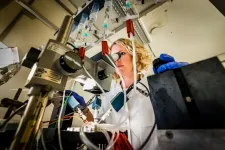(Press-News.org) New molecules, developed by researchers at Linköping University, have promising properties as possible drugs against epilepsy. A study published in the journal Epilepsia shows that several of the molecules have antiseizure effects.
In people with epilepsy, the nerve cells in the brain become overactive, causing epileptic seizures.
"More than 60 million people in the world have epilepsy. A third of them still experience seizures despite taking medication, so there is a pressing need for new types of drugs", says Nina Ottosson, principal research engineer in the Department of Biomedical and Clinical Sciences, Linköping University.
Nerve impulses are electrical signals that travel along nerves lightning-fast. Epilepsy and several other conditions arise when the nerves transmit signals far too readily, at times when they should be electrically quiet. The nerve impulses are created when small channels, known as ion channels, located in the membranes of the nerve cells allow electrically charged ions to pass through. When sufficiently many ions have entered a cell, an electrical impulse arises, which is transmitted along a long nerve fibre and subsequently stimulates other nerve cells. The ion channels thus play a key role in epilepsy. Many of the drugs currently used to prevent epileptic seizures act by affecting ion channels.
Previous work by the research group at Linköping University has shown that resin acids, which are found in the resin from pine and spruce trees, can affect certain types of ion channel. The scientists used these natural resin acids as a starting point to develop new, similar molecules. The long-term goal is to create drugs that prevent epileptic seizures.
In the newly published study, the researchers have examined an ion channel that affects how readily a nerve impulse is stimulated. This channel, the potassium ion channel denoted by hKV7.2/7.3, plays an important role in epilepsy. If it is closed, an epileptic seizure can occur, while the seizure can be stopped if the channel opens. One drug, retigabine, can open hKV7.2/7.3, and this was useful in treating severe epilepsy. Retigabine, however, affects other ion channels, in particular channels in the smooth muscle found in, for example, the bladder and blood vessels. This gave undesired effects, such as abnormally low blood pressure and difficulties in urinating. Retigabine was withdrawn a couple of years ago.
The researchers have shown in the study that several of the new resin acid molecules can open hKV7.2/7.3. They also investigated whether the molecules affect a closely related ion channel, hKV7.4, which is opened by retigabine and contributes to its undesired effects. Experiments in tissue from rats demonstrated that the new molecules have less effect on smooth muscle, and it is thus less probable that they give undesired effects on blood vessels and the bladder. The new resin acids influence ion channels using a different mechanism than that used by retigabine. The researchers believe that the difference in the mechanism of action is significant for the effects in different tissues.
"I believe that the mechanism for how our molecules act on ion channels can be extremely important. We hope that through future collaborations we can take our molecules along the complete pathway to a drug in clinical use", says Nina Ottosson.
Another important question is whether the new molecules can prevent seizures in a whole organism. The researchers thus investigated the effect of the molecules in zebrafish larvae in which epileptic seizures were provoked using a special substance.
"Several of the molecules had an antiseizure effect in these experiments when used at the same concentration as retigabine", says Nina Ottosson.
The scientists are now continuing to work towards a detailed understanding of how the resin acid molecules affect ion channels, and how they can be improved such that they can be used as drugs.
"Patients and relatives often contact me, and their stories show how pressing the need for effective treatments is. It would be amazing if some of those affected could be helped in the long term by our research. But at the same time, we must realise how incredibly difficult it is to take a molecule along the complete pathway to a new drug. Our results may also contribute to development by stimulating other research", says Fredrik Elinder, professor in the Department of Biomedical and Clinical Sciences at Linköping University.
INFORMATION:
The research has been conducted in collaboration with Sophion Biosciences A/S in Denmark and researchers at the University of Copenhagen. The experiments on zebrafish were carried out in collaboration with Bioreperia AB. Research funding has been obtained from, among others, the Swedish Research Council, the Swedish Heart-Lung Foundation, the Swedish Brain Foundation, Novo Nordisk Fonden and Parkinsonstiftelsen. Some of the researchers have applied for a patent for the resin acid molecules described in the study.
The article: "Synthetic resin acid derivatives selectively open the hKV7.2/7.3 channel and prevent epileptic seizures", Nina Ottosson, Malin Silverå Ejneby, Xiongyu Wu, Argel Estrada-Mondragón, Michelle Nilsson, Urban Karlsson, Melanie Schupp, Salomé Rognant, Thomas Andrew Jepps, Peter Konradsson and Fredrik Elinder, (2021), Epilepsia, published online on 4 June 2021, doi: 10.1111/epi.16932
https://doi.org/10.1111/epi.16932
A new robot - named WomBot - that can be used to explore and study wombat burrows is presented in a study published in the journal SN Applied Sciences.
Wombats reside and sleep in burrows and occupy a different burrow every four to ten days. Parasitic mites that cause sarcoptic mange, a serious disease affecting wombats, are thought to be transmitted when wombats occupy each other's burrows but it has not been clear whether conditions within burrows promote this transmission.
Researchers from La Trobe University and the University of Tasmania, Australia developed WomBot in order ...
For the first time, a unique study conducted at Lund University in Sweden has tracked the meteorite flux to Earth over the past 500 million years. Contrary to current theories, researchers have determined that major collisions in the asteroid belt have not generally affected the number of impacts with Earth to any great extent.
Researchers have been studying geological series since the 19th century in order to reconstruct how flora, fauna and the climate have changed over millions of years. Until now, however, almost nothing has been known about ancient meteorite flux - which makes sense since impact is rare, and the battered celestial bodies quickly break down as they encounter Earth's oxygen. A new study published in PNAS shows how researchers in Lund ...
New insight on the link between a gene called SORBS2 and congenital heart disease has been published today in eLife, with findings that may help explain the cause of the disease in some patients.
Some people with congenital heart disease are missing part of the long arm of chromosome 4, otherwise known as chromosome 4q. Chromosomes are thread-like structures made up of DNA. When part of the chromosome is missing, it means that some of the genes located on that section are also lost. Previous studies have linked heart defects related to chromosome 4q deletion syndrome ...
Converting Central American tropical forests into agricultural land is changing the colour and composition of natural material washing into nearby rivers, making it less likely to decompose before it reaches the ocean, a new Southampton-led study has shown.
The flow of dissolved organic material, such as soil, from land to the oceans plays an important role in the global carbon and nutrient cycles. Changing how land is used can alter the type and amount of material being transported, with widespread implications for ecosystems.
In this latest study, an international research team set out to learn more about the effects of deforestation on the coastal environment by studying material that flowed into rivers from various settings in a Central American rainforest, tracking its progress into ...
applying a thin sheath around the defective vein eliminated the varicose vein problem in over 95 per cent of cases. The research team published their findings in the Journal of International Medical Research on 6 April 2021.
When the blood pools in the leg
Varicose veins are more than just a cosmetic problem: the unsightly bulges might result in serious health problems such as leg ulcers, thromboses or even pulmonary embolisms. The cause of varicose vein disease is usually a weakness in the connective tissue, which causes the vein wall to give way and thus the vein diameter to grow. This process is accelerated by pregnancy or frequent standing and sitting.
The increase in vein diameter impairs the function of the vein valves. The valve leaflets are pulled apart and a leak ...
Weakened electrical signals in the brain may be an early warning sign of age-related neurodegenerative diseases such as Alzheimer's disease, suggests a study published today in eLife.
The findings hint at new ways to identify early on patients who may have an age-related brain disease. They also provide new insights on the changes that occur in the brain as these diseases develop.
"As tools for detecting Alzheimer's disease early are limited, there is a need to develop a reliable, non-invasive test that would enable early diagnosis," says first author Murty Dinavahi, who was a PhD Research Scholar at the Centre for Neuroscience, Indian ...
The Late Triassic Tianqiaoling flora is well-known in China, and its discovery has changed our understanding of Chinese Late Triassic phytogeographical divisions. More broadly, this flora has great significance for the study of phytogeography in East Asia during this time. However, the previous dating of this flora was only evidenced by plant fossils and stratigraphic correlation, and the accurate dating has still not been achieved. Recently, the team of Dr. Yuhui FENG of Shenyang Normal University collected isotope dating samples from the bottom of the Tianqiaoling Formation, which is conformally contacted the Tianqiaoling flora-bearing beds (Figure 1). The ...
Difficulty sleeping, sleep apnea and narcolepsy are among a range of sleep disorders that thousands of Danes suffer from. Furthermore, it is estimated that sleep apnea is undiagnosed in as many as 200,000 Danes.
In a new study, researchers from the University of Copenhagen's Department of Computer Science have collaborated with the Danish Center for Sleep Medicine at the danish hospital Rigshospitalet to develop an artificial intelligence algorithm that can improve diagnoses, treatments, and our overall understanding of sleep disorders.
"The algorithm is extraordinarily precise. We completed various tests in which its performance rivaled that of the best doctors ...
When sailing along on the seas and you suddenly spot a porpoise's fin in the distance, chances are that you have only encountered a single animal. Porpoises are most often seen alone, but new research now suggests that they also roam in groups - and even enter into a sophisticated collaboration when hunting.
The way they collaborate surprises us, because the common perception among biologists is that porpoises roam and hunt alone, says Associate Professor Magnus Wahlberg, who is an expert in marine mammals and heads the Marine Biological Research Centre at the University of Southern Denmark (SDU).
Drone footage has revealed group hunting among porpoises coming together to hunt schools of fish.
The research team has recorded almost 44 hours of drone footage from the waters around ...
Men who suffer sensory loss, particularly hearing loss, are more likely to be physically inactive and obese than women, according to a new study published in the European Journal of Public Health.
Researchers analysed data from more than 23,000 Spanish adults, and examined associations with physical inactivity and obesity in people with vision and hearing loss, and explored differences between men and women.
Results suggest inactive people with hearing loss were 1.78 times more likely to be obese compared to those who did not have any hearing loss. In people who had difficulty seeing, the odds ratio is slightly smaller, with a likelihood ...

